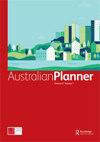Lifestyle cities, remote work and implications for urban planning
IF 1.2
Q2 Social Sciences
引用次数: 2
Abstract
ABSTRACT Australia’s cities and regions are the envy of the world for their natural beauty and lifestyle amenities and attractions. Not only has this sustained the tree-change and sea-change movement, with broadband connectivity and the COVID-19 pandemic so-called ‘e-changers’ and ‘flee-changers’ are part of the populus seeking to combine career aspirations with lifestyle destinations. This paper discusses the growing popularity of remote, particularly home-based work, and planning and design responses that accommodate this type of work in residential neighbourhoods. The issues are exemplified through a case study of the City of Gold Coast drawing on mixed methods including survey instruments and a design charrette facilitated by the authors. The design charrette is reported via three integrative narratives of a remote worker, the neighbourhood and the city. Findings outline preferences of remote workers towards built environment and urban design features enabling collaboration and knowledge exchange and assist in a better understanding of the socio-economic factors behind the spatial distribution of home-based work. The study’s findings offer a range of implications for appropriate urban planning and design responses.生活方式城市、远程工作和对城市规划的影响
摘要澳大利亚的城市和地区因其自然美景、生活方式便利设施和景点而令全世界羡慕不已。这不仅维持了树木变化和海洋变化运动,宽带连接和新冠肺炎大流行,所谓的“电子转换器”和“快速转换器”是寻求将职业愿望与生活方式目的地结合起来的民粹主义的一部分。本文讨论了远程工作,特别是在家工作的日益流行,以及在住宅区适应这类工作的规划和设计对策。这些问题通过黄金海岸市的案例研究得到了例证,该市采用了混合方法,包括调查仪器和作者促成的设计图纸。该设计通过远程工作者、社区和城市的三个综合叙事进行报道。调查结果概述了远程工作者对建筑环境和城市设计特征的偏好,这些特征有助于合作和知识交流,并有助于更好地了解家庭工作空间分布背后的社会经济因素。该研究的发现为适当的城市规划和设计对策提供了一系列启示。
本文章由计算机程序翻译,如有差异,请以英文原文为准。
求助全文
约1分钟内获得全文
求助全文

 求助内容:
求助内容: 应助结果提醒方式:
应助结果提醒方式:


